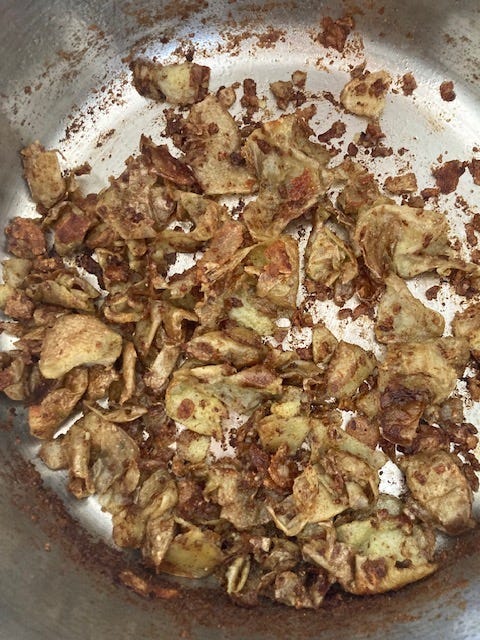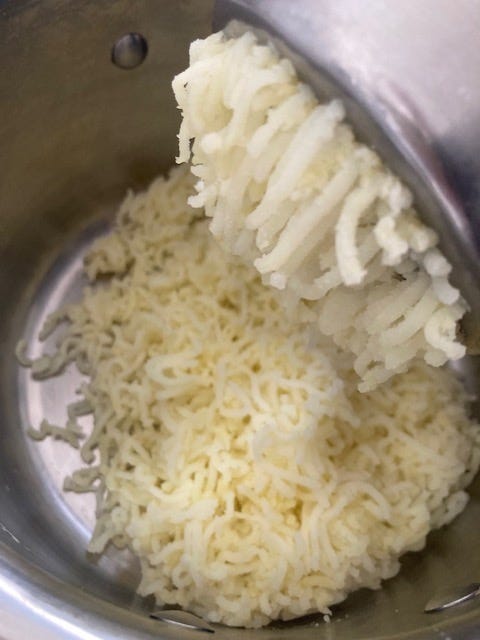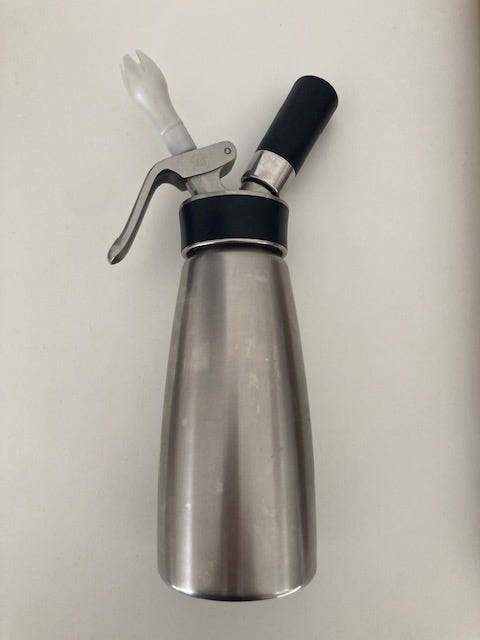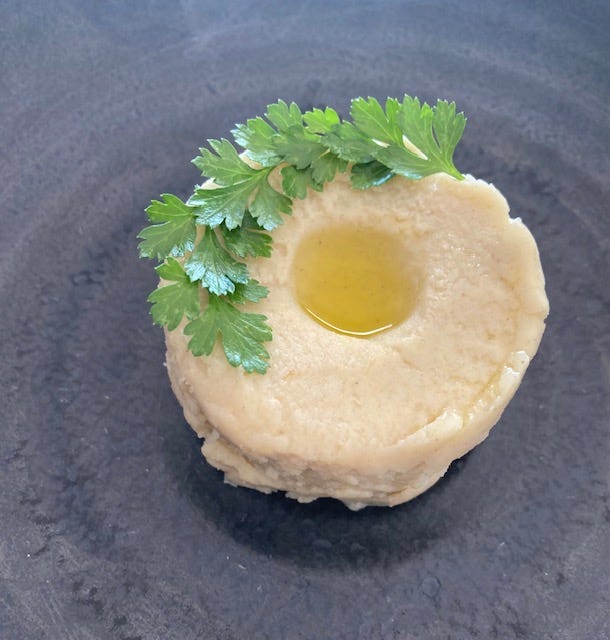Part 29. The December Foodie One. Two Pints Of Lager And A Packet Of Crisps Please
Jacket potato infused mash, Bloody Mary and a washing machine.
If you like spuds, and daft stories, please stick a like on the end of this. Thanks! You’re the best.
Good day to you, hope all is well. Right, this is the one where we talk about food, we know you’re excited about it!
So this time we want to talk your ears off about potatoes, spuds, or tatties.
Spuds are great, versatile, tasty and filling. And if you consider that even way back, around 1000 BC, the people of southern America were eating them with llamas. They’ve been around a while. But it wasn't until the 1500s that potatoes were spotted by a Spanish geezer who was knocking around the Columbia area, that they were even mentioned in Europe.
And potatoes didn't arrive in Great Britain until around 1588, and in later years, they replaced the turnip as a poor mans staple food. They became massively popular, they were easy to grow, they filled you up, and they kept very well in a dark cool area.
And the name, Spud? Various reasons for that. Some say that there was a short spade which was used to dig them up, the name of the spade came from the Danish word, Spyd, a spear type spade. Eventually, the name of the spade was transferred to the tuber. Or maybe the Society for Prevention of Unwholesome Diet, an Irish society set up to warn the Irish people about the problems of eating too many potatoes.
Anyway, you’re not here for a history lesson, but at least you now know that potatoes are older than Jesus.
But, in culinary terms, they're very useful, they were featured often and in various forms at Vanilla Black over the years.
You see, they absorb flavour very well, and they can be cooked so many different ways. And that was good for us, people expected to see them mashed, roasted or boiled, but you probably realise by now, that wouldn't be our approach to the humble spuddy.
It was the perfect opportunity for us to mix it up a little and serve potatoes in unusual and quirky ways.
How about this? We once did a dish based around seaweed and samphire. We needed to add a starch element and decided that potatoes would fit. But sticking boiled or roast potatoes on the plate was way too easy, why go all the way to a restaurant for those?
So, we bought in some Heritage potatoes, you know those don’t you? OK, basically, old varieties which have been forgotten about.
Do you want the story? Thought so. The tale we were told is that at one time there were many more varieties of potatoes on the market than we have now, and they were grown according to how they would be cooked. Some varieties were better for mash, some were better for boiling, some were better for deep frying, blah blah blah.
However, during one of the world wars, probably the second one, the government intervened. To reduce the reliance on imports, and to help feed the nation, some dead good people put their heads together and came up with an idea. Varieties were created which had high yield, were pest resistant and multi functional. Good all rounders.
These potatoes remained popular after the war due to them being a convenient crop, and slowly the old varieties became redundant. However, there were a few people who were concerned about this, and so they brought the old varieties back to life. This is the story we heard anyway.
There are now specialist growers who can sell you Red King Edwards, Pink Fir Apple and Shetland Black potatoes. Some varieties even have purple flesh, they don’t taste different, they just look very different.
We once read a ‘review’ online about Vanilla Black which accused us of dying the potatoes purple. Daft!
Well, that was a bit of a potatoey detour wasn’t it.
So, we took some purple heritage pots, and pickled them. We boiled them first, then cooled them and soaked them in a semi sweet pickle to which was added a little seaweed, just to tie it to the seaweed and samphire in the dish. The potatoes were heated through to order in the oven, then placed alongside the seaweed element.
One bloke asked why we pickled potatoes, he seemed annoyed at what we had done. So I asked him why we ever take a beautiful green crisp apple, peel it, cover it in sugar, hide it in a pudding bowl, top it with crumble, then bake it at 180c until it was soft and mushy.
Why take a bright red, summer tomato, and spoil it by chopping it up finely, then adding it to a pan with an onion and cloves of garlic and then cook it until it’s a sloppy sauce. I didn't offer any more examples, as he listened he slowly started to nod his head.
Another one? We once had a miniature Bloody Mary (without the Voddy) as a pre starter, but it needed something to pair with it. So we decided that a few crisps would be very lovely. We got to work, ordered in some miniature potatoes, shaved them on a mandolin, then put blue plasters on our fingers. Then we deep fried the potato slices and sprinkled on a little celery salt to replace the celery in a traditional Bloody Mary. Miniature Bloody Mary and little crisps.
If you like reading this and feel like dropping three squid our way for a coffee, then thank you.
Another? OK. Because we always wanted to smash up stereotypes we decided to do a curry. Kinda. You see, because we were a vegetarian restaurant, many people expected us to have some kind of veggie curry on the menu. Cauliflower Balti, Vegetable Laksa, or Sandal Vindaloo. Yes, we had none of those. But we did have our take on a potato and lentil Dhal. Deconstructed Puy Lentil Dhal, Potato Purée, Curry Oil and Crispy Lentils.
We used Puy lentils, these were more expensive than red lentils, so Beanbag Cafe didn’t touch them. Plus they held their shape, they had definition. Some were boiled and seasoned with curry oil, the rest were soaked overnight, drained, dried, then deep fried until crispy. We then took some spuds, cooked them, then puréed them with some cream. We also added different garnishes, such as candied chillis or deep fried curry leaves.
So the dish became a version of a dhal. But the problem with a dhal is that just about every spoonful, or forkful, tastes just like the last one. But our dhal had different textures on one plate, and they all related to a dhal. Get it? It was a popular dish, it hung around for a while, some customers would return and often order it without looking at the menu.
OK, one more, and this one has a bit of a recipe. I think we stole part of this recipe from a restaurant called El Bulli, can’t quite remember. Anyway, our legendary Whipped Jacket Potato dish came about like this.
We always used existing dishes as inspiration, and jacket spuds are a classic.
But could we just put jacket potatoes on the menu at Vanilla Black. Well we could have, but why would you bother leaving the house when you can make them yourself at home. Or you could have popped down to World Peas Cafe, they would have definitely had them on the menu. So, we set about creating the Vanilla Black version of a jacket spud.
Firstly, we took some potatoes, then we microwaved them until they were cooked. Microwaved them!!!! Yes, stop it with the microwave stigma, that comes from the huge restaurant chains pulling a tray of Spaghetti Carbonara from a case in the freezer and nuking it for five minutes. But microwaves are a useful cooking tool. More about such things in another foodie edition.
Right, think about this, if you boil potatoes, they become wet, if you bake them, they become too dry. But if you microwave them, they aren't wet, but they also haven't become dried and shrunken. That means that you can peel them easily, mash them, and they're still dry enough to absorb twenty eight kilos of butter and cream.
So we microwaved them, then peeled them, then we fried the peelings until very browned and then added some cream. This was left to infuse for just over an hour.
In the meantime, we used a potato ricer to create a smooth and silky mash, and then added some salt, then passed the cream through a fine sieve into the mash.
So you ended up with mashed potatoes which had a back taste of jacket potato. But it didn’t end there.
We then added this jacket potato flavoured mash to an ISI siphon (Google it) and injected nitrous oxide into it. This process gave the potato a mousse like texture.
To carry on the jacket potato story we added some Ribblesdale cheese into a small bowl. Then the jacket potato mousse was injected from the canister into the bowl to cover the cheese. So the cheese was starting to melt.
Finally, it was topped off with tomato syrup, battered mini onion rings and then sprinkled with vinegar dust.
So there you have it Whipped Jacket Potato, Ribblesdale Cheese,Tomato Syrup, Little Onion Rings and Vinegar Dust.
It was a lot of work just to replicate a jacket potato, but the whole point was, you couldn't get this dish anywhere else.
Hey, Barry from Tripadvsor, that’s why the restaurant was so ‘expensive’.
Don’t forget, this was the whole point of Vanilla Black, giving people something they hadn't had before.
It was a fun dish and raised a lot of eyebrows, but again, like the dhal, it became very popular.
If you fancy making this yourself, you can’t. I don’t think you can buy nitrous oxide capsules unless you can prove you need them for culinary purposes. I think the law changed a few years ago.
But guess what kids, you can make a jacket potato flavoured mash.
Here we go, a loose recipe. I can’t be bothered with writing up properly, but you don't really need much information.
Next time you’re peeling some potatoes, keep a good handful of the peelings (make sure they don’t have any soil on them) and throw them in a bag or a bowl then freeze them. You’ll need them for the recipe.
Right, on we go.
-Weigh some spuds, you need about 700g, but if they're a little under or over, don't worry. Try to have them similar sizes. Clean them.
-Stab them with a fork, then, microwave on full power for around 15 minutes, depending on your microwave. Turn them a couple of times. When a knife goes into them, they're done.
-When you can handle them, peel them with a little knife, you won’t need a peeler. Make sure you don’t let them cool down though, you must do this while they are warm.
-Keep the peelings. Then add 25g butter to a saucepan, or a good glug of oil.
-Add the peelings to the pan, along with 50g of the frozen peelings. Remember them?
-Fry on a low heat until very brown. They'll stick but don't worry, just scrape the brown bits off the bottom of the pan.
-When browned, add 200g single cream, bring back to a boil and simmer for one minute.Turn off. Allow to infuse for twenty minutes.
-While the skins are browning, mash the potatoes in a bowl or pan, this must be done while they're warm. Alternatively, pass the spuds through a ricer, they're great machines.
-Add a teaspoon of salt to the potato, then place a fine sieve over the bowl or pan and add the peelings and cream to the sieve. Press the skins with the back of a spoon to get all that lovely skin flavour into the mash.
-Then simply mix the salt and skinny cream into the potato.
-Eat it.
But wait, could you do this process with onions also? Fried onion flavour mash? Dunno, try it and see what happens.
Now then, two funny stories for you.
This is story number one. Remember Big Kev, my old boss from years ago? Well it’s about him. Many years ago you didn’t see washed potatoes, they actually had soil on them. We used to do these little potatoes cooked with garlic and herbs, and we served them with the skin on, little mini things they were. But washing two hundred portions was painful. Now, Big Kev had the solution. He came in one day and unloaded an automatic washing machine from the van, and then he plumbed it in. Then we loaded the little spuds into the machine, and put them on a rinse cycle. It was perfect.
Story number two. My old friend Stevie G was approached by a guy who had just opened a new restaurant. This was many years ago, in an era when loaded potato skins were a thing. Do you remember them, thick potato skins, deep fried and served with chilli con carne or cheese? Well this guy wasn't from the restaurant world, but he’d been to London and seen these amazing potato skins, and he wanted them in his restaurant, but he didn't know how to make them. So he asked Stevie G how to make them. Stevie showed him, it wasn't exactly difficult, it was just a case of cutting thick peelings from around the potato. Basically, peeling a spud but making the peelings thicker.
Anyway, the restaurant was very popular, and it became well known for these fancy loaded potato skins. He must have been making a fortune. Some time later, Stevie was chatting to this guy. Stevie mentioned the famous loaded skins and asked the bloke, just out of interest, what he did with the potato that was left in the middle, you know, after taking the thick peelings off.
His reply was, “Oh, I just chuck ‘em in the bin”.
There we are people. Catch you next time for more real world restaurant stories.
Thanks for reading, Andrew and Donna.









Big Kev gets my vote for employee of the month. Did he go on to great things?
Inspiring potato creations, thank you.
I still remember that jacket potato mash! I think I just kept muttering that it was mash but it tasted of a lovely crunchy jacket potato and how did they do that? I only had to wait a decade or so …